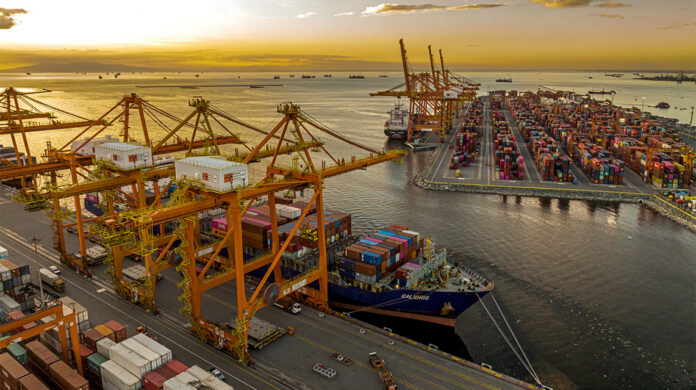-
ICTSI invests P900M for MICT IT over last decade
-
Online payment system being developed for launch this year at ICTSI’s terminals in Manila North Harbor, Subic, and Cagayan de Oro
-
5G-integrated projects in the pipeline include truck driver messaging, remote safety monitoring using intelligent surveillance systems and remote crane monitoring using Internet of Things devices and sensors
-
MICT to launch online examination viewing portal now pending Department of Agriculture approval
International Container Terminal Services Inc. (ICTSI) invested more than P900 million (US$20 million) in information technology in the last 10 years for its flagship Manila International Container Terminal (MICT).
“The hefty investments in technology are meant to crisis-proof the terminal, safeguard shipments and system processes, maximize the efficiency of its operations and maintain ICTSI’s world-class brand of customer service,” ICTSI executive vice president Christian R. Gonzalez said in a statement.
READ: ICTSI bares projects supporting digital transformation
Setting the stage for future technology and digital service deployments at MICT, ICTSI partnered with PLDT last year for the roll-out of 5G at the terminal.
MICT is using the technology to automatically weigh containers through spreader load cells in rubber-tired gantries (RTG). Having this feature helps shorten truck drivers’ stay at the port as they no longer need to queue to use the terminal’s weigh bridges.
ICTSI said 5G technology is an important cornerstone of MICT’s journey towards becoming the first smart port in the Philippines.
Other 5G-integrated projects in the pipeline include truck driver messaging, remote safety monitoring using intelligent surveillance systems and remote crane monitoring using Internet of Things devices and sensors – all aimed at improving safety and efficiency of port operations while reducing foot traffic inside the terminal, ICTSI said.
In 2015, ICTSI launched the Terminal Appointment Booking System (TABS) at MICT to facilitate the seamless flow of cargo in and out of the port.
ICTSI said MICT is working on the TABS Manifesting System, which automatically captures container data and truck plate numbers during the booking process.
Once the system is deployed, drivers no longer have to input anything at the terminal kiosks upon their arrival.
A new MICT app is also being developed. The app is designed to give port users access to several services, such as Track & Trace, across multiple ICTSI terminals, online payment, and eventually TABS booking. It will include features such as GPS location and estimated time of arrival, as well as geofenced gate-in and yard locations for drivers.
With the goal of improving its enterprise resource planning system, ICTSI recently tapped Rimini Street – a third-party support provider for Oracle and SAP – to provide support for business-critical functions including financials, treasury, asset tracking and equipment maintenance and repair.
ICTSI said the support and robust platform enables the company to focus more on addressing emerging market requirements and capitalizing on future market opportunities.
At the height of the COVID-19 pandemic, the port operator invested in technology-driven solutions that, it said, were key to MICT’s uninterrupted operation despite the nationwide lockdowns that threatened the country’s supply chain.
As ICTSI moved to safeguard the welfare of employees at MICT by providing COVID vaccines and instituting rigid health protocols and remote work arrangements, these technologies helped keep the terminal functioning and open for business 24/7, the port operator said.
MICT’s online payment system also enabled customers to process their transactions without physically going to the terminal. Launched in 2017, the system had a mere 30% adoption rate before the pandemic. With lockdowns in place and COVID-19 cases ballooning in 2020, ICTSI said customers relied on the system as the primary means of paying for their transactions.
“The billing process at MICT was not affected by the lockdowns as customers started using the online payment system. From 30%, the system’s adoption rate grew to 100% as clients realized they can conveniently and safely transact with us without going to the port,” Gonzalez said.
A similar payment system is also being developed for ICTSI’s other Philippine terminals, including North Port, Subic Bay International Terminals, and Mindanao Container Terminal. The system is scheduled for launch within the year.
“These technologies have been in place at the MICT for quite some time now and have proven to be game-changing, especially during the pandemic. We focused on optimizing these existing systems and accelerated the development of other digitally enabled services to make our terminals more efficient even with limited personnel on site,” Gonzalez said.
Aside from launching an online payment system, MICT is gearing up to launch its online examination viewing portal pending approval from the Department of Agriculture.
The portal will enable customs brokers to observe the Bureau of Customs’ examination of containers without being physically present at the terminal.
READ: BOC kicks off online viewing for cargo examination
For transactions that require a visit to the port like container returns and pull-outs, MICT has systems in place to limit face-to-face interactions.
The terminal gates are automated and have been unmanned since 2015. Instead, optical character recognition, license plate recognition and radio frequency identification technologies facilitate the seamless entry and exit of trucks.
“ICTSI will continue to take advantage of new technologies to push our efficiencies for the benefit of our customers,” Gonzalez said.





